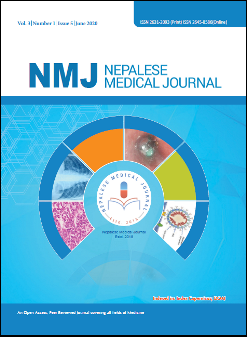Role of Non-Invasive Mechanical Ventilation for Acute Respiratory Failure in Cancer Patients
DOI:
https://doi.org/10.3126/nmj.v3i1.28289Keywords:
Intensive care unit, Lung Carcinoma, Non-invasive ventilation, PneumoniaAbstract
Introduction: Acute respiratory failure is a common cause of Intensive care Unit admission for cancer patients. Non-invasive ventilation comes in between the two extreme situations: either provide only oxygen or ventilate invasively. This study was done to find the usefulness and efficacy of non-invasive ventilation in a cancer patient.
Materials and Methods: A cross-sectional study was done at Nepal Cancer Hospital. Data analysis of patients requiring non-invasive ventilation at the Intensive care Unit from April 14, 2018, to April 13, 2019, were included.
Results: Among 68 studied patients, the primary reason for the initiation of non-invasive ventilation sepsis (16.32%), pneumonia (10.88%), and lung cancer (10.2%). Postoperative atelectasis, pulmonary edema, and morphine overdose were associated with good respiratory improvement and Intensive care Unit survival (100%, 75% and 66.67% respectively). Respiratory failure with carcinoma lung, lung fibrosis, acute respiratory distress syndrome, terminally ill patients, and patients with low Glasgow Coma Scale had high failure rates (Survival: 13.33%, 14.29%, 16.67%, 0%, and 20% respectively).
Conclusions: Non-invasive ventilation seems to be an effective way of ventilation for cancer patients. The selection of patients and timely initiation of non-invasive ventilation is of utmost importance for a better outcome.
Downloads
Downloads
Published
How to Cite
Issue
Section
License
This license enables reusers to distribute, remix, adapt, and build upon the material in any medium or format, so long as attribution is given to the creator. The license allows for commercial use.
Copyright on any article published by Nepalese Medical Journal is retained by the author(s).
Authors grant Nepalese Medical Journal a license to publish the article and identify itself as the original publisher.
Authors also grant any third party the right to use the article freely as long as its integrity is maintained and its original authors, citation details and publisher are identified.




